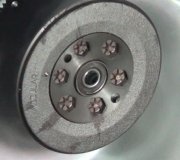Hi Zaren. Welcome to the forum. The transmission you have is either the 904 or 727. The pan on a 904 is basically a rectangle with one corner shaved off a little. The 727 is the same but has an extra 2" bump-out on the right front corner. It was a really tough unit until they hung an overdrive gear on the back of it. Both transmissions use the same valve body, mounts, and external linkages but the clutch packs and other rotating parts are larger in diameter than the 904's. Both are easy to rebuild. Unlike GM and Ford transmissions that require a box full of special cones and tools, the Chrysler transmissions require a three-dollar seal tool for the clutch packs. I had rotten luck with the front clutch piston seal on the 904. There are tricks to installing it without cutting it, but I wrecked that seal twice so I gave up and installed a 727 instead in my car.
I cannot say what the differences are related to hooking it to a transfer case, but up front there are three versions of each transmission. One case bolts to the slant six cylinder engines. Another one bolts to any small block engine, (273, 318, 340, and 360), and one case bolts to the big block engines, (361, 383, 400, 413, 426 wedge, 426 hemi, and 440). The 727 can be bolted to an engine in place of the 904 but the tail housing is 4" longer so a 4" shorter drive shaft is needed on cars. I think the tail housing is removed when it is bolted to a transfer case, but I cannot remember for sure.
The cooler lines may have been leaking or the cooler itself might have been rusted through inside the radiator. If you pull off the hose from cooler in the radiator and see green antifreeze come out, the cooler is leaking. Hose pressure from the transmission can reach 10 psi, but coolant pressure can reach 15 psi so coolant will be forced into the transmission when the engine is hot. Transmission fluid would be forced into the radiator when the engine is cold. The coolant will be dark brown and rubber hoses will be soft and mushy. Petroleum products such as transmission fluid rots rubber hoses from the inside. If the cooler is leaking internally, it would be less expensive to add an external transmission cooler in front of the radiator than to replace the radiator.
If you see red fluid or nothing at all from the cooler lines, chances are the steel lines were just leaking. The original lines had no rubber hoses anywhere in them. They were solid steel all the way from the transmission to the radiator. They were long enough to flex with engine vibration and movement.
As for not shifting, there's a good chance there is varnish buildup in the valve body. First look at the kick down linkage. If it still uses a series of metal rods from the engine to the lever on the driver's side of the transmission, it could be disconnected. If the lever is sitting in the position of wide-open-throttle, it will need a really high road speed to upshift. Newer versions use a cable that can get rusted tight and stick in the heavy acceleration mode. That lever should move freely by hand and spring back to the low throttle position easily when released.
If the linkage is working freely, suspect varnish buildup in the valve body. The shift points are set by two valves; the throttle valve which is connected to the lever you just checked, and the governor valve on the output shaft. The spring-loaded governor valve moves in its bore from centrifugal force due to drive shaft speed. When its pressure due to road speed overcomes the throttle valve's pressure due to gas pedal position, the shift valve moves to initiate the gear change. The most common symptom of a sticking governor valve is a failure to downshift to first gear when you slow down but it could also prevent an up shift. As I recall, the throttle valve is not spring-loaded. It has to move with the kick down linkage. A shift valve could also be sticking. Most of those valves do not use springs, just fluid pressure to set their positions.
Before you tear into the transmission, you might try an additive that is supposed to dissolve any varnish buildup. Some must be drained out after doing their job. They are not meant to be left in for a long period of time. Other additives are designed to remain in the transmission. These are commonly called "shift improvers".
Caradiodoc
Thursday, June 24th, 2010 AT 2:11 PM


